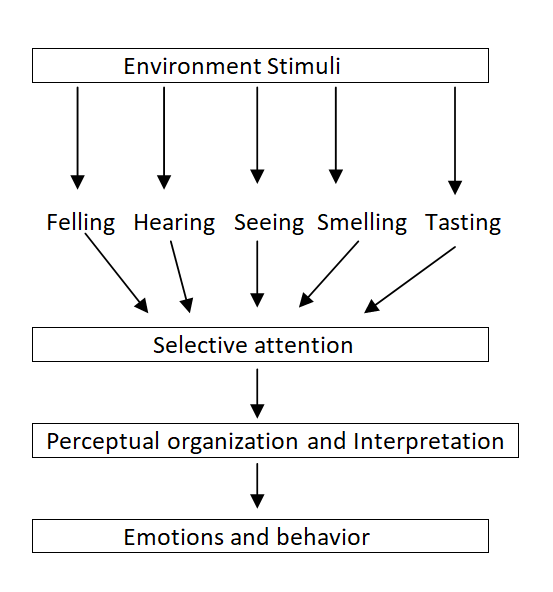Perception:
Perception is the process by which people select, organize and interpret sensory stimulus into meaningful information about their work environment. The knowledge is captured by interpreting the sensory input. Perception is more than sensory input supplied by sense organs and other receptors. It is the final product of raw and unprocessed sensations.
Definition by S.P. Robbins
| Perception is defined as the process by which an individual selects, organizes, and interprets information inputs to create a meaningful picture of the world. |
| Perception is a process by which an individual organizes and interprets their sensory impressions to give meanings to their environment. |

Feature of Perception:
- The base of every individual’s behavior
- Psychological process
- Differs from person to person and situation to situation.
Perceptual Process(Model)
A Simple Model of the Perceptual Process:

The model has 3 variables: Input, Processes, and Output.
Inputs:
Perceived inputs are the objectives, events, people that are received by the perceiver which begins when environmental stimuli are received by our five sense organs.
Processes:
Input received is processed by this sub-process:
- Selection,
- organization, and
- interpretation.
a. Selection:
Our five senses are instantly bombarded with the varieties of inputs, so we cannot react instantly with those simultaneous stimuli or inputs. Therefore, there needs a process of filtering those bombarded simultaneous or instant stimuli, this process is called selection.
Why there is a selection process:
Because of the following reasons;
- Goal-oriented nature of human beings as we are attracted to our own personal interests.
- The selection process actually solves the overloading of perceptual handling.
- People generally select the information either that is the most important for them or they are the most threatening for them.
- Also, human’s perception is that they only perceive what they want to perceive. For example; in a group picture, an individual only sees himself/herself at first, then only to the others. Next example; in a student’s cultural program, parents only perceive their own children’s performance.
Selection perception follows two main principles:
- Figure-Ground principle
- Relativity principle
Figure-Ground principle:
The significant portion is called the Figure, and the insignificant or meaningless portion in any perception is called Groud. According to Gestalt psychology, it is known as identifying an object(figure) from the background(ground). This principle solely depends on the observer but not the object or an item.
Relativity principle:
This principle is nothing but it only indicates that we only perceive the perceptions that are only relevant and attached to ourselves. We don’t care about those perceptions which are irrelevant to us.
b. Organization:
The organization is the process by which we group selected information and finally perceive the perceptions from those stimuli. It means to figure out the objects, recognizable patterns, assembling the information which will give a meaningful whole information. The methods of organization are:
- Grouping: It is the concept that information is selected based on similarity or proximity. For example; if more than half a student fails on the same subject, the principal might guess, it is because the concerned teacher of that subject could not teach the students properly.
- Closure: It is the concept that people will fill the incomplete information. Generally, it indicates that we are addicted to full meaning, so if we get half or incomplete information, we interpret them ourselves, whether it may be right or not. Example: People will perceive COMP as a computer or company or anything complete but not as a comp which is incomplete meaning.
- Simplification: To make the information, people generally use this process. For example; People use this process because they want to end the burden of unnecessary information.
c. Interpretation:
If there is no interpretation, perceived information would be meaningless. It is highly subjective and judgemental in nature. In real-life situations, interpretation is influenced by many factors or perceptual errors. This is called the final judgment of meaningful information.
Output:
The output of perception can be seen in the form of behaviors and emotions. They may be the feelings, attitudes, actions, etc.
Perception and Individual Decision Making:
Decision-making is an overall package of thinking, deciding, and action. And, it is affected by an individual’s perception. Every manager at all level of management are required to make a decision, and that depends upon the perception of those individual managers. So, we can conclude these two have an intense connection in the businesses. Example:
- Top-level managers decide over the organization’s goals, type of production, services to offer, etc.
- Middle-level managers decide over production schedules, and recruiting new employees, and so on.
- Low-level managers decide over whether to go for work or not(today), how much time and effort to work for, whether to follow the boss or not? etc.
Decision-Making steps:
1. Defining the problem
A perceived discrepancy between the current state of affairs and the desired state. Every decision problem requires selection, organization, and interpretation of information.
2. Developing Alternatives
Every decision requires the development of alternatives. It also requires the development of relevant alternatives.
3. Making a Choice
It is the selection of the best alternative. The final choice is influenced by the perception of the decision-maker.
You may also like Leadership || Motivation and Leadership || Organizational Behavior. If you liked our content HTML Editor, then Please don’t forget to connect with us through our social media sites. Facebook: Bcis Notes, Instagram: @bcisnotes, and Twitter:@bcisnotes.

Leave a Reply